Related Research Articles

Argyll and Bute is one of 32 unitary council areas in Scotland and a lieutenancy area. The current lord-lieutenant for Argyll and Bute is Jane Margaret MacLeod. The administrative centre for the council area is in Lochgilphead at Kilmory Castle, a 19th-century Gothic Revival building and estate. The current council leader is Robin Currie, a councillor for Kintyre and the Islands.

Dunoon is the main town on the Cowal peninsula in the south of Argyll and Bute, Scotland. It is located on the western shore of the upper Firth of Clyde, to the south of the Holy Loch and to the north of Innellan. As well as forming part of the council area of Argyll and Bute, Dunoon also has its own community council. Dunoon was a burgh until 1976.

Earl of the County of Mayo, usually known simply as Earl of Mayo, is a title in the Peerage of Ireland created, in 1785, for John Bourke, 1st Viscount Mayo. For many years he served as "First Commissioner of Revenue" in Ireland. He had already been created Baron Naas, of Naas in the county of Kildare, in 1776, and Viscount Mayo, of Moneycrower in the county of Mayo, in 1781, also in the Peerage of Ireland.

Cowal is a rugged peninsula in Argyll and Bute, on the west coast of Scotland. It is bounded on the west by Loch Fyne and on the east by Loch Long and the Firth of Clyde. The Kyles of Bute separate it from the Isle of Bute to the south.

Earl or Lord of Clanricarde is a title that has been created twice in the Peerage of Ireland, first in 1543 and again in 1800. The former creation became extinct in 1916 while the 1800 creation is extant and held by the Marquess of Sligo since 1916.

The House of Burgh or Burke was an ancient Anglo-Norman and later Hiberno-Norman aristocratic dynasty who held the earldoms of Kent, Ulster, Clanricarde, and Mayo at various times, provided queen consorts of Scotland and Thomond; many kings of Britain and multiple other royals, and played a prominent role in the Norman invasion of Ireland.

William de Burgh was the founder of the House of Burgh in Ireland and elder brother of Hubert de Burgh, 1st Earl of Kent and Geoffrey de Burgh, Bishop of Ely. William is often given the epithet, "the conqueror", but is not to be confused with the English king of the same nickname.
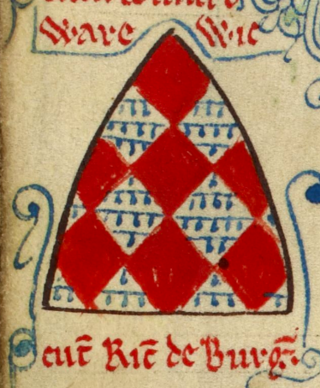
Richard Mór de Burgh, 1st Lord of Connacht, was an Anglo-Norman aristocrat who was Seneschal of Munster and Justiciar of Ireland (1228–32).
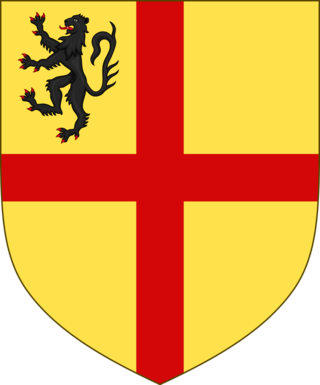
Sir Uilleag (Ulick) de Burgh (Burke), 1st Clanricarde or Mac William Uachtar was an Irish chieftain and noble who was leader of one of the three factions who fought the Burke Civil War in the 1330s. By the end of the conflict he had established himself and his descendants as Clanricarde, also known as Mac William Uachtar, independent lords of Galway. He was succeeded by his son, Richard Óg Burke, 2nd Clanricarde (d.1387).
Ulick na gCeann Burke, 12th Clanricarde or Mac William Uachtar, 1st Earl of Clanricarde was an Irish noble and son of Richard Mór Burke, 9th Clanricarde by a daughter of Madden of Portumna.

Clan Arthur or Clan MacArthur, is a highland Scottish clan that once held lands on the shores of Loch Awe opposite Inishail. The clan has been described as one of the oldest clans in Argyll. Clan Arthur and Clan Campbell share a common origin, and at one point the MacArthurs challenged the seniority of the leading Campbell family. A branch of MacArthurs from the Isle of Skye were a sept of the MacDonalds of Sleat, and were hereditary pipers for the MacDonalds of the Isles. In late 18th century the chief of the clan died without an heir, leaving the clan leaderless until the late 20th century. In 2002, the first chief of Clan Arthur was recognised in about 230 years.
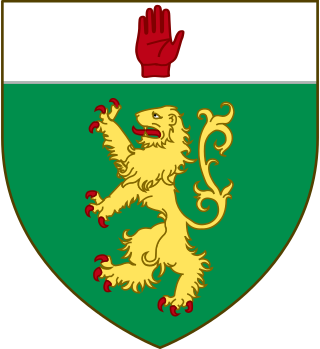
Magennis, also spelled Maguiness, Maginnis, Magenis, McGinnis, McGinnas, or McGuinness, is an Irish surname, meaning the "son of Angus", which in eastern Ulster was commonly pronounced in Irish as Mac Aonghusa. A prominent branch of the Uíbh Eachach Cobha, the Magennises would become chiefs of the territory of Iveagh, which by the 16th century comprised over half of modern County Down, Northern Ireland. By the end of the 17th century, their territory had been divided up between them, the McCartan chiefs and English prospectors.
Events from the year 1597 in Ireland.

de Burgh is an Anglo-Norman surname deriving from the ancient Anglo-Norman and Hiberno-Norman noble dynasty, the House of Burgh. In Ireland, the descendants of William de Burgh (c.1160–1206) had the surname de Burgh which was gaelicised in Irish as de Búrca and over the centuries became Búrc then Burke and Bourke.

Carter-Campbell of Possil is a branch of Clan Campbell, a Scottish clan. Historically, they are part of Clan Campbell, which was regarded as one of the largest Scottish clans. The branch of the Campbell clan was historically centred in Lawers. Some of the clan, which originated with the original Campbells, had links to the lands of Argyll.

Dunoon Burgh Hall is a municipal building in Argyll Street, Dunoon, Scotland. The structure, which is used as an events venue, is Category B listed.

Robert Alexander Bryden was a Scottish architect, prominent in the second half of the 19th century. He was mainly active in the west of Scotland, where he designed schools, churches and municipal buildings.

de Búrca is an Irish Anglo-Norman surname deriving from the ancient Anglo-Norman and Hiberno-Norman noble dynasty, the House of Burgh. In Ireland, the descendants of William de Burgh (c.1160–1206) had the surname de Burgh which was gaelicised in Irish as de Búrca and over the centuries became Búrc then Burke and Bourke.
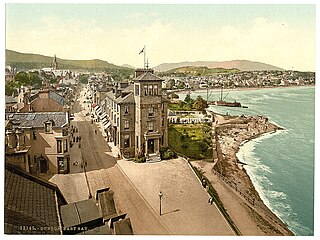
Argyll Street is the main street of the Scottish town of Dunoon, Argyll and Bute. It runs for about 0.9 miles (1.4 km), from Pier Esplanade in the south to Bencorum Brae in the north.
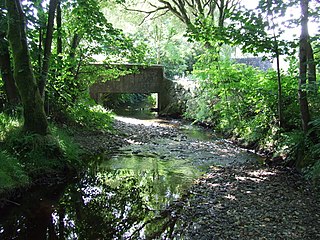
Milton Burn is a watercourse in Argyll and Bute, Scotland. It is sourced from Loch Loskin in Kirn and largely runs parallel to the A885 road as it leads south to Dunoon. It is around 1.02 miles (1.64 km) long.
References
- ↑ McLean, Angus (1982). The Place Names of Cowal: Their Meaning and History. Dunoon Observer and Argyllshire Standard. p. 112.
- ↑ "Milton House History – Dunoon Grammar School" . Retrieved 4 May 2023.
- ↑ Mosley, Charles, editor. Burke's Peerage, Baronetage & Knightage, 107th edition, 3 volumes. Wilmington, Delaware, U.S.A.: Burke's Peerage (Genealogical Books) Ltd, 2003
- ↑ "Dunoon Burgh Hall Chronicles" (PDF). Dunoon Burgh Hall. 1 June 2017. Retrieved 15 January 2022.